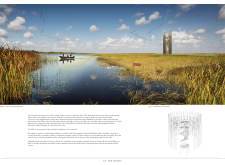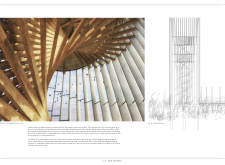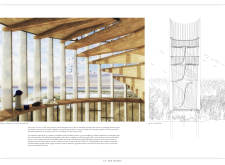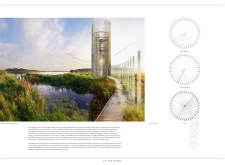5 key facts about this project
### Project Overview
The bird observation tower, situated on the southern shore of Pope’s Lake within Pope Nature Park, is designed to integrate with the surrounding wetlands while enhancing the experience for visitors. The structure facilitates birdwatching and serves as an educational platform to promote awareness of local ecosystems. This design merges functional requirements with aesthetic considerations and ecological sensitivity.
### Material Selection
The project's construction materials prioritize sustainability and durability. Key components include:
1. **Steel Blades**: Vertical steel elements form the tower's perimeter, providing structural integrity while offering unobstructed views of the surrounding landscape.
2. **Local Timber**: Incorporated in flooring and staircases, local timber contributes warmth and tactile quality, enhancing the welcoming atmosphere for users.
The combination of the industrial nature of steel and the organic characteristics of timber achieves a balance between strength and natural texture.
### Structural and User Experience
The observation tower is characterized by its slender form, with steel blades that taper towards the top, echoing the movement of reeds and ensuring structural stability against environmental forces. A circular staircase spirals upwards, providing access to multiple observation decks and facilitating panoramic views of the wetlands.
Upon entering the tower, visitors experience a spatial composition that highlights openness and light. The contrast of timber and steel enriches the interior, creating a layered sensory experience. The strategically placed viewing platforms promote activities such as birdwatching and contemplation, allowing users to engage with natural elements like light and sound, thereby enhancing their connection to the environment.
Unique features of the design include its contextual integration with the park's topography, dynamic form that redirects wind while ensuring safety, biomimicry principles inspired by nesting behaviors, and a user-centric approach that accommodates diverse visitor needs.






















































